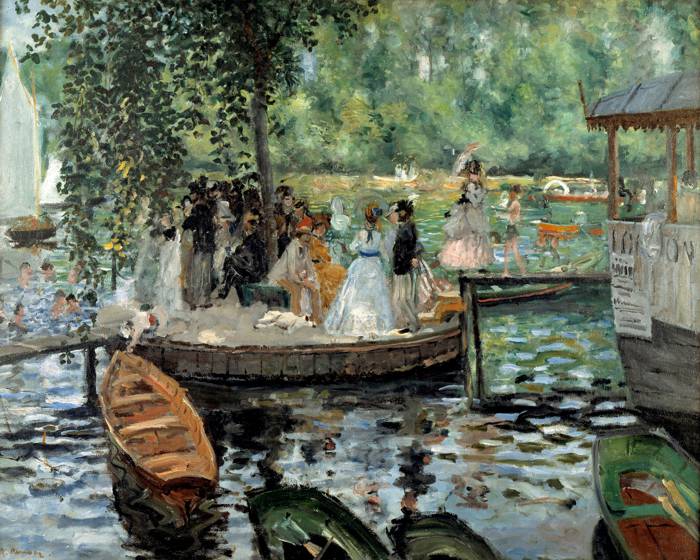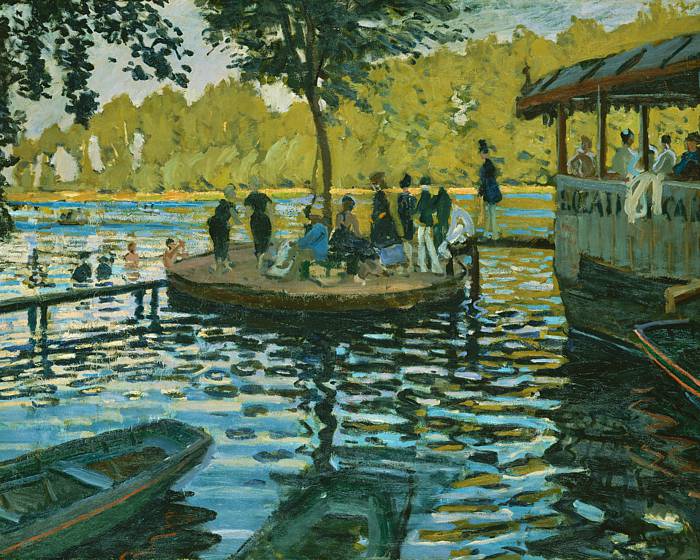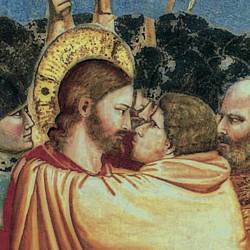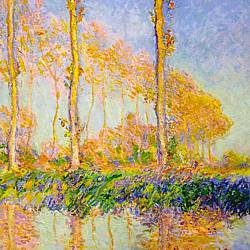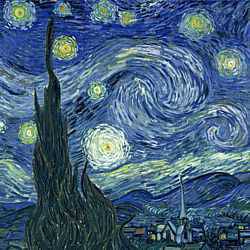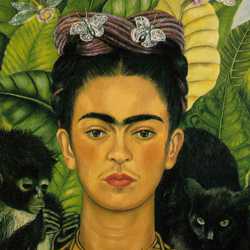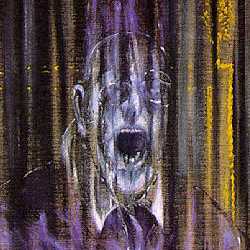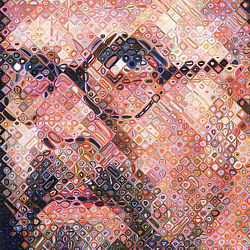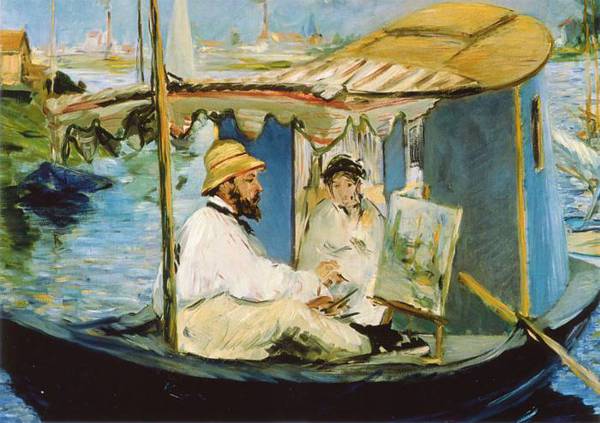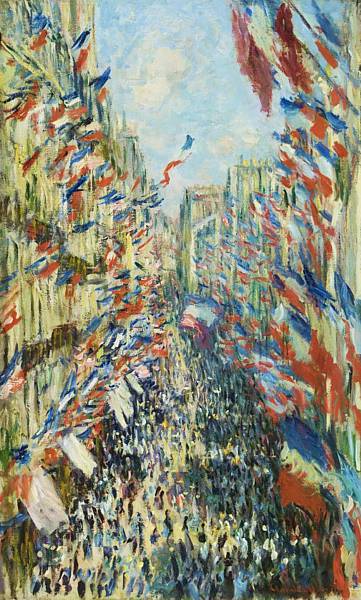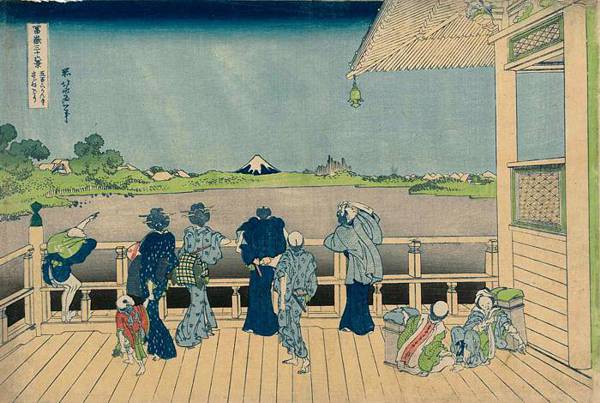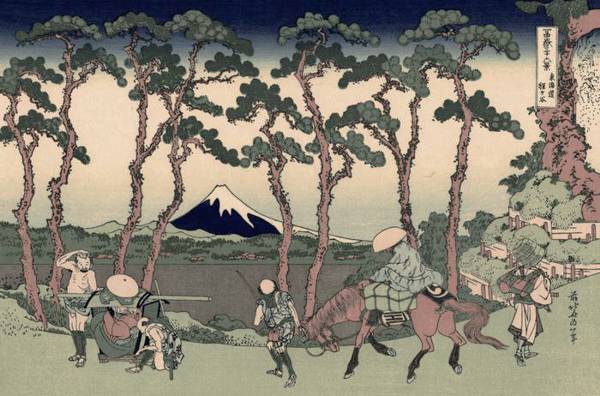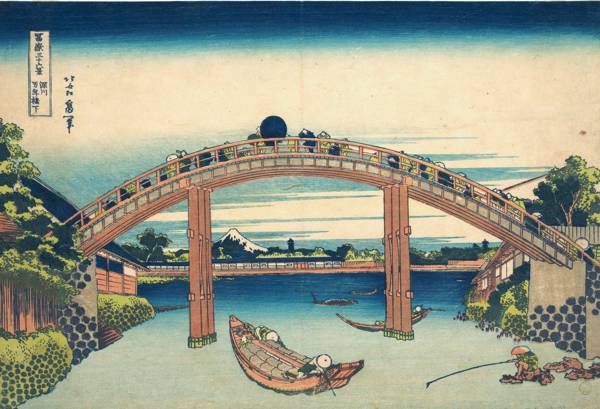Paintings by Claude Monet
Claude Monet was a co-founder and the most celebrated artist of the French Impressionist movement. He was an artistic colossus who stands with one foot at the beginning of modern art and the other at its end.
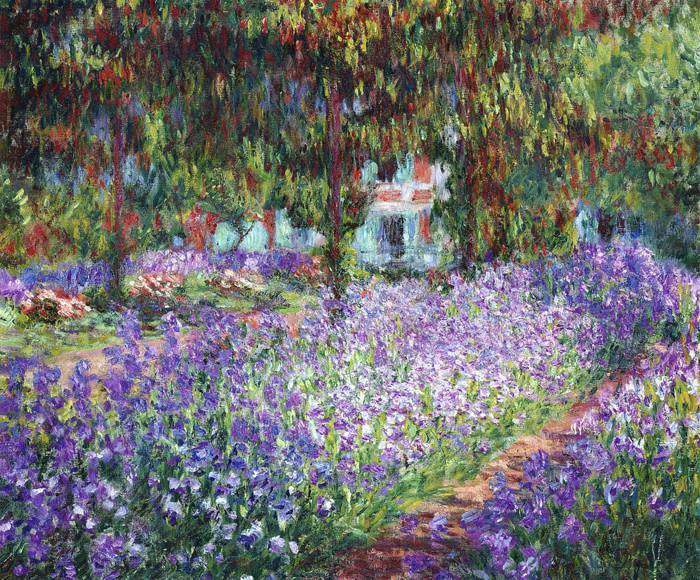
CLAUDE MONET (1840 -1926)
'Irises in Monet's Garden', 1900 (oil on canvas)
Claude Monet was a co-founder and the most celebrated artist of the French Impressionist movement. He was born in Paris in 1840 but at the age of 5, when his father Adolphe took over the family business, he moved to the town of Le Havre on the Normandy coast. He showed a natural talent for drawing as a boy which was encouraged by his mother Louise and his aunt, Sophie Lecadre, but less so by his father who envisaged him following in his own footsteps.
Eugène Boudin, a local artist who shared the same picture framer as the young Monet, took an interest in his development and introduced him to 'plein-air' [1] painting. This was an activity he grew to love and pursued throughout his career, working outside in all weathers to capture the changing moods of the landscape.
In 1859, Monet left for Paris to study art. His father wanted him to attend the prestigious Ecole des Beaux-Arts, but Monet preferred the Académie Suisse, a progressive independent art school that was popular with contemporary artists such as Camille Pissarro. His father viewed this choice as an act of defiance and cut him off from any financial support. In 1862, Monet entered the studio of Charles Gleyre where he met and worked with other leading artists of the Impressionist group such as Pierre Auguste Renoir, Edouard Manet and Alfred Sisley.
Estranged from his family, Monet endured many years of poverty before his paintings began to sell. However, like most good artists, the accumulation of wealth was always secondary to his artistic ambition. He worked tirelessly, unwilling to compromise his vision, and by the end of his life he had achieved both fame and fortune as the foremost painter of the French Impressionists.
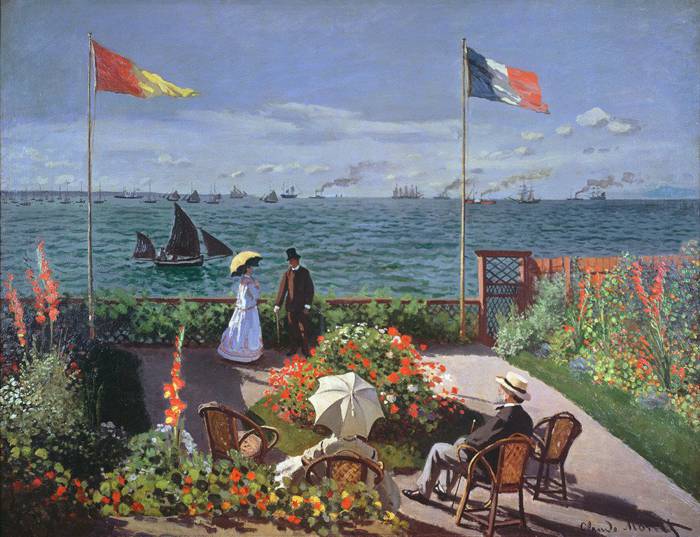
CLAUDE MONET (1840 -1926)
'The Terrace at Sainte-Adresse', 1866 (oil on canvas)
The 'Terrace at Sainte-Adresse' is an early work that portrays Monet's father and aunt sitting in wicker chairs on her garden terrace. Although by today's standards this a conservative image of the bourgeoisie at rest, it introduces radical Impressionist ideas about light, color, 'alla prima' [2] painting and the influence of Japanese woodblock prints.
In the formative years of Impressionism many of the artists both socialized and worked together sharing their ideas about art. In this picture the influence of Manet is quite visible in its flatly painted planes of sky, sea and terrace. These emphasise the pattern of the composition, a homage to the 'Ukiyo-e' [3] genre of Japanese prints. Renoir actually referred to this work as 'the Japanese painting'. One obvious source for its inspiration may be the 'Turban-shell Hall of the Five-Hundred-Rakan Temple' from the suite of prints '36 Views of Mount Fuji' by Katsushika Hokusai (1760-1849). Monet owned a copy this print which, to this day, still hangs in his house in Giverny.
At this point in time, Monet's painting style is still in its early stages of development. Nevertheless, it gives us an indication of what is to come in his bold use of color and expressive brushwork for the flowers and foliage around 'The Terrace'.
LEFT: CLAUDE MONET (1840 -1926) / RIGHT: PIERRE AUGUSTE RENOIR (1840-1902)
'La Grenouillère (tr. Frog Pond)', 1869 (oil on canvas)
In the summer of ‘69, Monet and Renoir painted side by side at 'La Grenouillère' (trans. The Frog Pond), a leisure resort on the River Seine, popular for boating, bathing and its floating restaurant. Monet was despondent at his lack of success in the Salon exhibitions and was desperate to find a subject that had mass-appeal. He felt that La Grenouillère met all his requirements as it attracted people from all classes and accommodated his passion for painting reflections on water.
At this time Monet and Renoir were on the breadline, sharing both provisions and paint on their journey to what would later be called 'Impressionism'. They also shared their ideas about painting and at first glance their work of this period seems almost indistinguishable. Both their paintings of 'La Grenouillère' have the same composition and preoccupation with the effects of light and color on rippling water. Even so, you can still see the distinguishing characteristics of each artist's work that point to their future interests. The river in Monet's painting has greater vitality than Renoir's, while the figures in Renoir's painting have more life and character than Monet's. Each artist was learning from the other, becoming more aware of their strengths and weaknesses. Monet would go on to focus almost exclusively on landscapes, to the extent where he built his own at Giverny, while Renoir would concentrate on figure painting and portraiture.
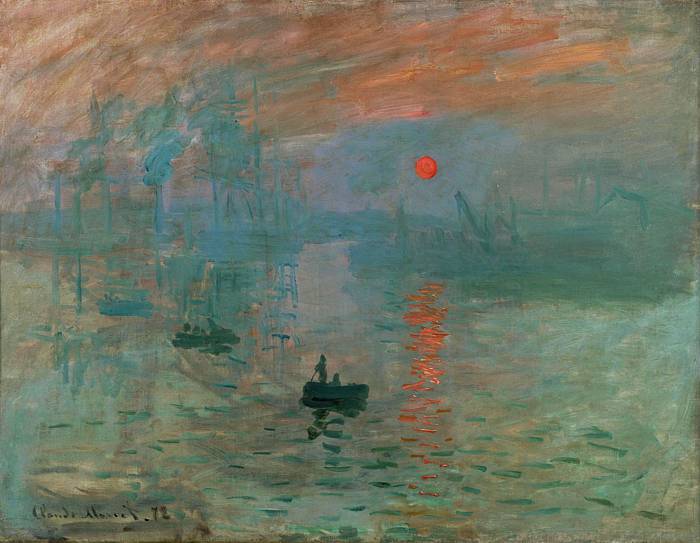
CLAUDE MONET (1840 -1926)
'Impression Sunrise', 1872 (oil on canvas)
Monet's painting 'Impression Sunrise', which lent its name to the Impressionist movement, is a view of the harbour in Le Havre. When it was first exhibited at the 'Salon des Refusées' of 1874, Monet's vigorous brushwork was seen by the artistic establishment as sketchy and uncontrolled. In a review of that exhibition mockingly titled 'The Exhibition of the Impressionists' after Monet's landscape, the critic Louis Leroy sarcastically wrote 'Impression—I was certain of it. I was just telling myself that, since I was impressed, there had to be some impression in it ... and what freedom, what ease of workmanship! Wallpaper in its embryonic state is more finished than that seascape.'
Although Monet's painting ignored the traditional historical and allegorical subjects that appealed to the establishment, what caused the critics most discomfort was freedom of the brushwork he used to express the ephemeral qualities of light and color. Monet worked in the moment, editing what he saw and what he felt about it at the time. This was a more modern approach to painting that observed and responded to the world as it was, not as how others believed it should be.
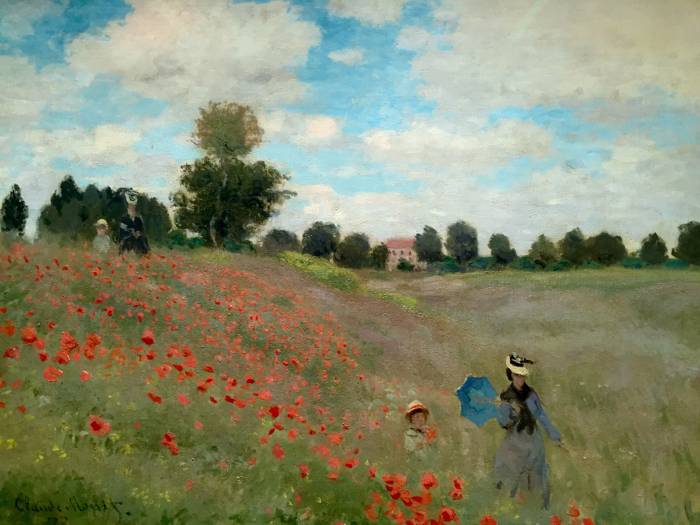
CLAUDE MONET (1840 -1926)
'Wild Poppies', 1873 (oil on canvas)
“Everything that is painted directly and on the spot always has a force, a power, a vivacity of touch that is not to be found in studio work.” Eugène Boudin (1824-98)
Wherever Monet lived, he drew his inspiration from the local landscape. In 1871, after evacuating his wife Camille and son Jean to London to avoid the Franco-Prussian War, Monet returned to set up home in Argenteuil on the River Seine, a small village about 20 kilometres from Paris. Camille inherited some money in 1873 which relieved any financial pressure and allowed them to relax and enjoy the pleasures of life on the river.
‘Wild Poppies’ is a characteristic image of this happy and productive period. It depicts Camille and Jean walking through a field of poppies on a pleasant afternoon. Monet actually paints them twice, at the top and bottom of the hill, creating a diagonal path that leads the eye from the background to the foreground. He bridges the distance between the figures with the diminishing rhythm and size of his brushstrokes and the contrast of his colors. In the foreground, the inordinately large red poppies jump out of their complementary green field, gradually reducing in both size and contrast as they recede harmonically into the distance.
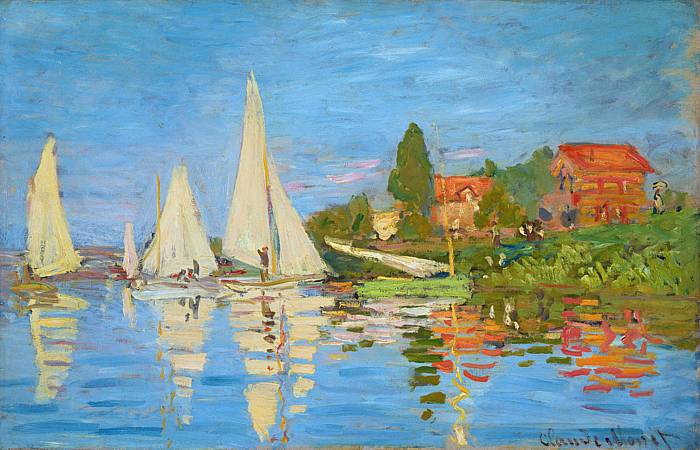
CLAUDE MONET (1840 -1926)
'Regatta at Argenteuil', 1872 (oil on canvas)
It was in Argenteuil that Monet matured as an artist producing vibrant images of the surrounding landscape with its boats and bridges reflected on the shimmering water. He so loved to paint the effects of light and color on the river that he built a floating studio on a boat to more directly immerse himself in that environment. The play of light on the surface of water fascinated him and became one of the major themes of his work.
In 'Regatta at Argenteuil' the fluidity of Monet's brushstrokes mimics the fluctuation of light on the surface of the water. His energetic technique is perfectly suited to this subject matter. Although the atmospheric quality of the scene is loosely painted, it is secured within a tightly structured composition. The vertical masts of the yachts intersect with the horizontal riverbank to create a mirrored image in the water. This makes visual sense of his boldly painted reflections - a sense that required less formal assistance as his work matured.
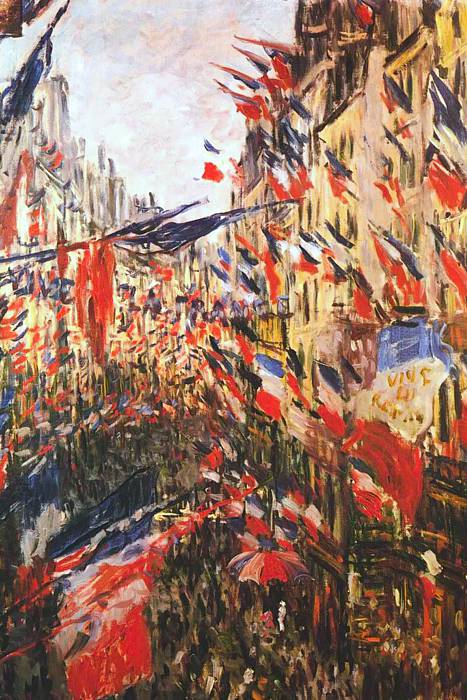
CLAUDE MONET (1840 -1926)
'La Rue Saint-Denis. Celebration of June 30', 1878. (oil on canvas)
Monet's tranquil scenes of the Argenteuil countryside contrast dramatically with his lively views of Parisian streets. However, despite the obvious differences in their content, their real subject matter was essentially the same: the atmospheric effects of light and color at a particular time and place.
In ‘La Rue Saint-Denis’, which has an almost identical twin painting, 'La Rue Montorgueil', Monet paints an explosion of red, white and blue tricolors that reflect the fervour of Republican support on a national holiday. In the centre of the painting, one banner displays the slogan 'Vive La France' while another distorts the rallying cry 'Vive La Rep(ublique). Monet views the scene from a third-floor balcony, whose high eye level allows him to express the enthusiasm of the crowd through the vibrant display of flags, economically described in the language of Impressionist brushstrokes.
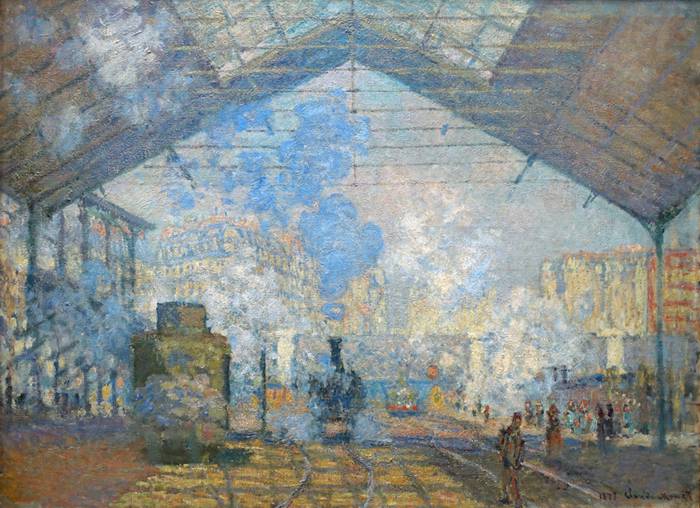
CLAUDE MONET (1840 -1926)
'La Gare St. Lazare', 1877 (oil on canvas)
One painting that embodies all the characteristics of Monet's early work is 'La Gare St. Lazare'. It is one of a series of twelve canvases that explore the effects of light in the steam filled atmosphere of a station. Today we view steam trains with a gentle nostalgia, a symbol of bygone times. However, in Monet’s day the railway was a symbol of modernity and a most suitable subject for the most modern of artists.
This is an interior view of the station from the end of the tracks, looking out beyond the trains to the sunlit city. The scene is filtered through a haze of steam that billows up from the engines to fill the terminal. It both obscures and illuminates the station as it reflects and refracts the sunlight streaming through the glass roof. The station shed acts like a cloud chamber to contain these ephemeral effects and its roof window like a lens to project light through them. The geometric lines of girders in the roof cast their shadow on the ground forming a tight perspective grid, a rigid counterbalance to the turbulent motion of the steam. In 'La Gare St. Lazare' Monet found a versatile motif: not simply a view of the station, but a controlled environment that could be painted at different times of day and under different atmospheric conditions to record the shifting relationships of light and color.
Monet went on to explore various subjects through series of images that work both individually and as a group. Included in these were his paintings of Haystacks (1890), Poplars (1891), Rouen Cathedral (1892-94), the Houses of Parliament (1899-1901) and ultimately his own garden at Giverny. He understood that the Impressionist technique had a limited lifespan before it became a clichéd painting style. By working in series Monet expanded the nature of Impressionism to include the changing conditions of a subject over a period of time: he moved it beyond a technique for recording 'what we see' to the wider concept of 'how we look'. It was this shift in perception that lifted his work above his contemporaries and established him, not just as the greatest of the Impressionists but as a 'modern artist'.

CLAUDE MONET (1840 -1926)
'Poplars', c.1891 (oil on canvas)
In 1891 Monet painted a series of 'Poplars' on the banks of the River Epte near Giverny. They were initially painted from his studio boat where he would store several canvases that he could switch around as the light changed. With such a short window of opportunity available to catch a specific effect, he would work quickly. When the light faded, he would put that canvas aside to work on it the next time he encountered similar conditions. Once he felt he had captured the particular mood he was seeking, he would take the painting back to his studio to adjust, refine and balance its visual elements.
There is almost a musical quality to these paintings. The movement of the vertical tree trunks along the horizontal riverbank determines the tempo of the composition, which is modulated by the lyrical patterns of the leaves that trail through planes of sky and water. The abstract rhythms of the tree trunks and the progressions of shapes, colors and tones in the foliage yet again nod in the direction of Japanese art, particularly Hokusai's 'Hodogaya on the Tokaido'. Monet had a collection of over 230 Japanese woodblock prints, a passion that most of the Impressionists shared.
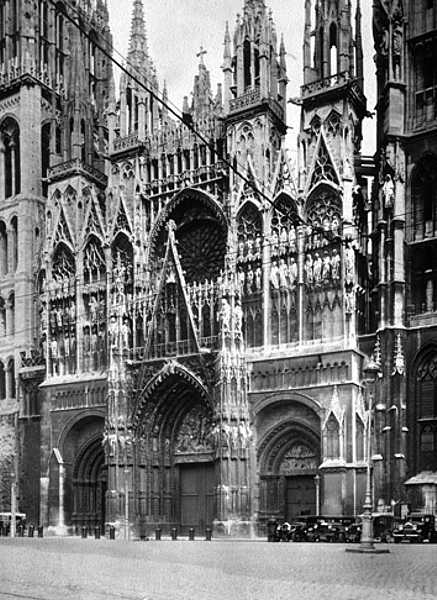
Rouen Cathedral facade (photograph)
The most significant of Monet's 'series' artworks were his paintings of Rouen Cathedral. For some time he had thought that 'it would be interesting to study the same motif at different times of day and to discover the effect of the light which changed the appearance and coloration of the building, from hour to hour, in such a subtle manner.' Rouen Cathedral became that motif.
Between 1892 and 1893 he painted around thirty pictures from a room he rented in a shop across the road from the cathedral. These were first-hand studies which he finished to a greater or lesser degree and then reworked in his studio during the following year.
If you look at a photograph of Rouen Cathedral you can see that it has a very ornate Gothic facade which is difficult to paint in a detailed manner. Monet used the intrinsic qualities of his Impressionist painting technique to simulate its intricate surface with a heavily textured pattern of brushstrokes to suggest the erosion of the weathered sandstone.
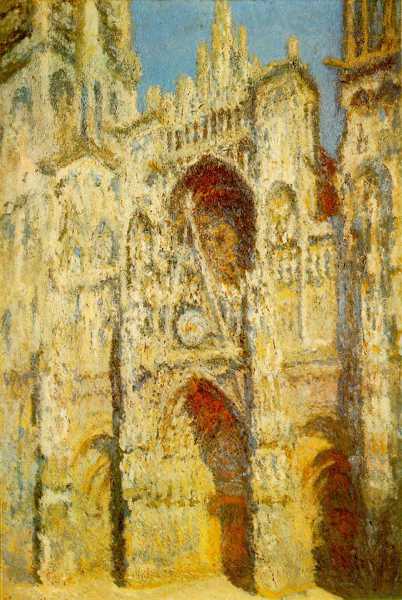
CLAUDE MONET (1840-1926)
'Rouen Cathedral in Full Sunlight -
Harmony in Blue and Gold' 1893
(oil on canvas)
The Impressionists had rejected the old idea that the shadow of an object was made up from the colour of the object with some brown or black added. They avoided the use of brown and black. The range of colours Monet used was drawn from the spectrum. He did not mix up his colours before he painted them, but broke them down into their separate hues and then painted them in small strokes of pure colour next to each other. For example, if he was painting a green object he would paint strokes of yellow and blue together which, on being viewed from a distance, would form a green in the eye of the spectator. Another technique he used was to tint his shadows with complementary (opposite) colours to give them more vitality. For example, in this painting of 'Rouen Cathedral in Full Sunlight' he creates the brown shadows of the building by painting strokes of yellow and red to make orange and then darkens them with spots of blue. All this is done with strokes of pure unmixed colours which blend in the eye of the viewer.
- Rouen Cathedral - Study of Portal (1892)
Rouen Cathedral - Study of Portal (1892)
- Rouen Cathedral - Portal at Midday (1893)
Rouen Cathedral - Portal at Midday (1893)
- Rouen Cathedral - Morning Effect (1894)
Rouen Cathedral - Morning Effect (1894)
- Rouen Cathedral – At Noon (1894)
Rouen Cathedral – At Noon (1894)
- Rouen Cathedral - Magic in Blue (1894)
Rouen Cathedral - Magic in Blue (1894)
- Rouen Cathedral - In the Morning Fog (1894)
Rouen Cathedral - In the Morning Fog (1894)
- Rouen Cathedral - At Sunset (1894)
Rouen Cathedral - At Sunset (1894)
- Rouen Cathedral - Symphony in Grey and Rose (1894)
Rouen Cathedral - Symphony in Grey and Rose (1894)
- Rouen Cathedral - Grey Weather (1894)
Rouen Cathedral - Grey Weather (1894)
- Rouen Cathedral - Evening, Harmony in Brown (1894)
Rouen Cathedral - Evening, Harmony in Brown (1894)
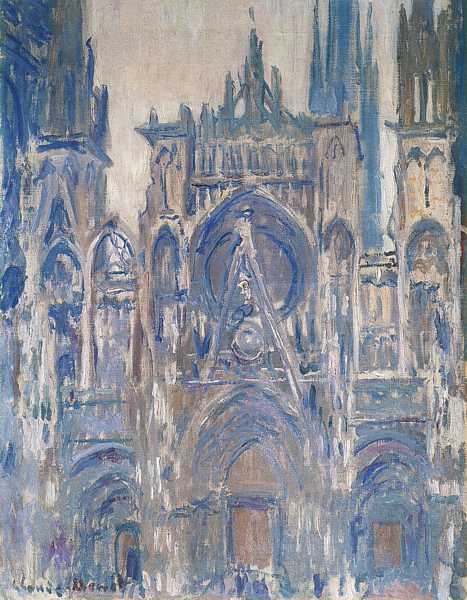
When the Rouen Cathedral series was finally completed in 1895, some twenty canvases were hung together in an exhibition, showing the passage of time from dawn to dusk. The painter, Camille Pissarro, was struck by their originality and wrote to his son, 'I am sorry you will not be here before Monet's exhibition closes; his Cathedrals will be scattered here and there and they should be seen as a whole.'
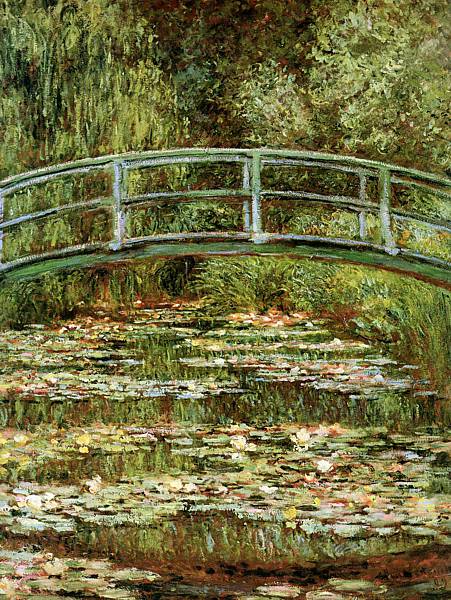
CLAUDE MONET (1840 -1926)
'The Water Lily Pond: Green Harmony', 1899 (oil on canvas)
When Monet was moving from one series of paintings to another, he was always in search of a subject that would allow him to witness that moment in nature when the light, color and atmosphere of the landscape combine in sublime harmony. This search concluded when he constructed his magnificent garden at Giverny, a small village in the Normandy countryside, about 80km northwest of Paris. In 1883 Monet rented a house there with studio outbuildings and two acres of orchard attached. By the 1890’s he had earned enough from his paintings to purchase the property as well as an adjoining water meadow.
Monet had always been a gardener, but his development at Giverny was on an extraordinarily ambitious scale. He redesigned the garden in two stages. First, he uprooted the orchard and planted the flower garden with a profusion of different blooms that provided a continuous display of color all year round. Then, in 1893, he flooded the meadow by diverting the River Ru to create his exotic water garden with its water lilies, irises, wisteria, bamboo, rhododendrons, weeping willows, poplars and alders. Near the entrance to the water garden, Monet built a Japanese footbridge across the pond. He based his design on an image from a Japanese print, 'Under the Mannen Bridge at Fukagawa' by Hokusai, and painted it green to harmonize with its surroundings.
Monet’s garden was the inspiration for the great paintings of his final decades. It was an extension of his art that allowed him to compose and control the elements of a natural landscape that he used to ‘model’ his ideas in paint.
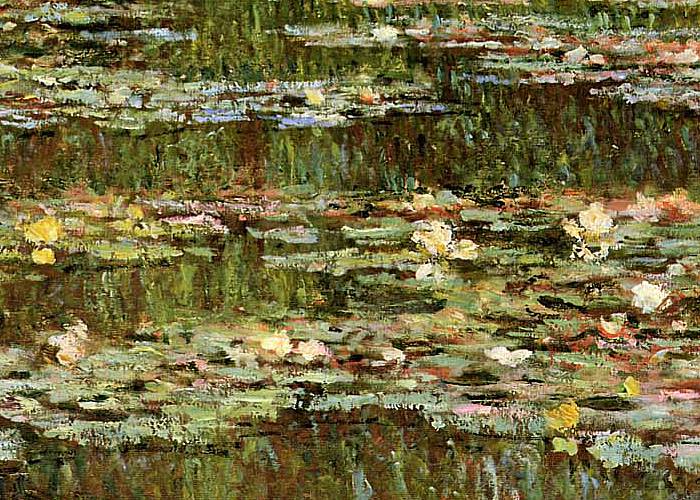
CLAUDE MONET (1840 -1926)
Detail from 'The Water Lily Pond: Green Harmony', 1899 (oil on canvas)
In Monet's previous series of 'Poplars', his compositions had grown more abstract. He had begun to flatten the image by reducing its depth of field with horizontal and vertical forms arranged parallel to the picture plane. The flattening of the composition continued in his 'Japanese footbridge' series, as he lowered his viewpoint to remove the sky. This type of cropping technique was a device that many Impressionist painters borrowed from the new art of photography.
In 'Water Lily Pond: Green Harmony', Monet crops the image to exclude all but the bridge, the lush vegetation of the pond and its surrounding undergrowth. The result is a magical glade of shimmering green light, punctuated by cream, pink, yellow and orange water lilies. The convex arch of the bridge cuts the painting in two and is counterbalanced by its concave, copper-brown reflection at the bottom of the picture. Monet builds up the detail with layer upon layer of paint gradually thickening his brushstrokes to reach a crescendo of colorful highlights. The result is so rich in color and texture that on close examination, all you can perceive are the glorious harmonies of abstract color. It is only when you stand back, does the painting come into focus as the 'Water Lily Pond'.
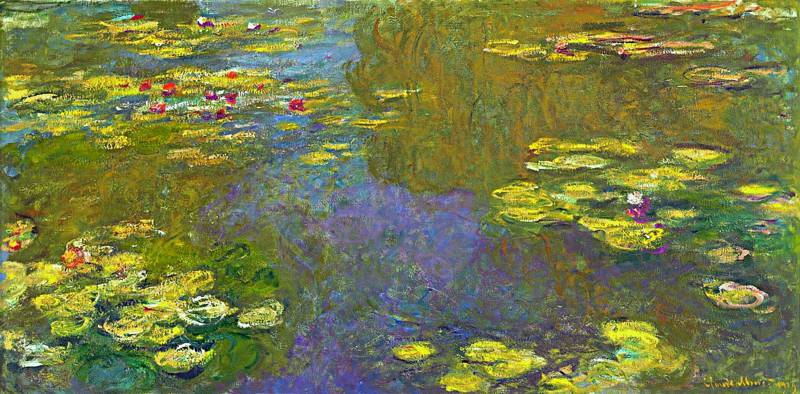
CLAUDE MONET (1840 -1926)
'Water Lilies', 1919 (oil on canvas)
In Monet's last great series of 'Water Lilies', he lowers his viewpoint once more to focus only on the surface of the water. By cropping both the horizon and the edges of the pond, he abandons the traditional arrangement of space in a painting, i.e. foreground, mid-ground and background, substituting them with an expanse of three correlating elements: the plants on the surface of the water; the reflections off the surface of the water; and plants beneath the surface of the water. This creates an abstract field of shifting relationships of color and form, modified by the changing effects of the light and the atmospheric conditions in his water garden. The infinite combinations of these ephemeral elements absorbed Monet's interest for around 20 years until his death in 1926.
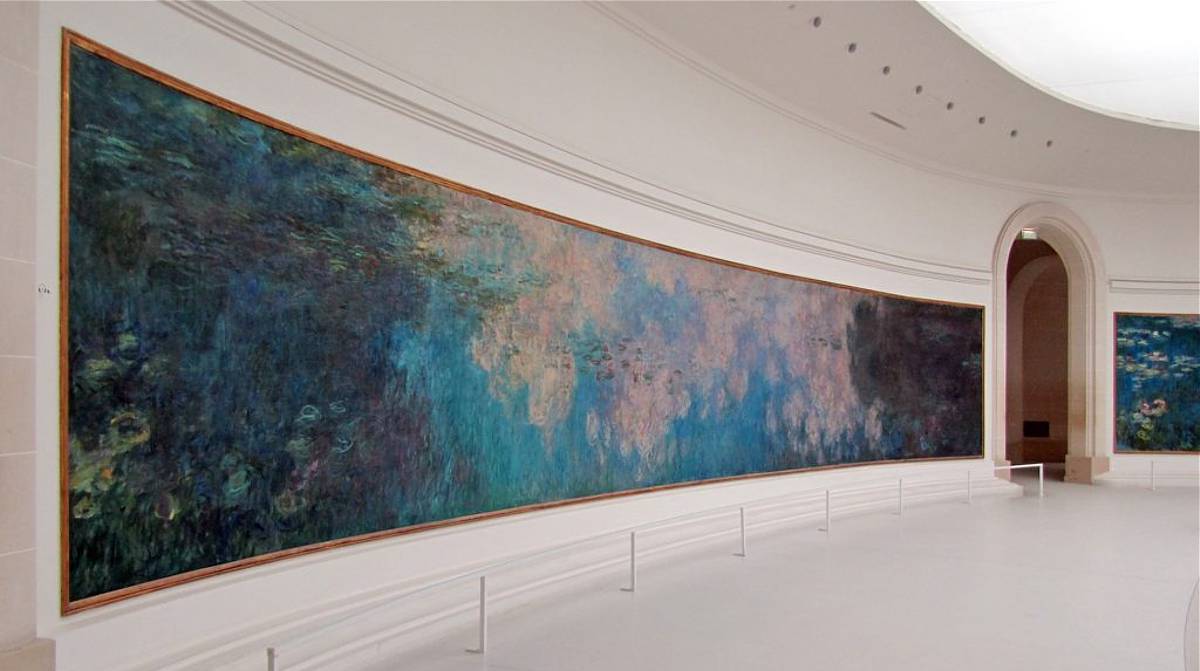
CLAUDE MONET (1840 -1926)
'Water Lilies - The Clouds', 1920-26, oil on canvas (6'6" X 41'7")
1 of 8 canvases in a circular series at the Musée de l'Orangerie'
Monet also developed the immense scale of these paintings to control the way we look at them. The eight 'Water Lilies' canvases that circle the walls of the Musée de l’Orangerie in Paris, are just under 2 metres high and about 100 metres long in total. You cannot look at these paintings in the same way you would look at a typical 3ft by 2ft Impressionist painting, as their sheer size makes it impossible to experience them as a complete image. Their protracted scale, which extends beyond your peripheral vision, pulls you into the mystery of their hidden depths. Our perception of their expanding space is enhanced by the circular arrangement of the canvases as you walk around the gallery. In essence, Monet was addressing the limitations of the compositional cropping he employed in earlier works. He was taking painting beyond the perimeter of the traditional canvas to generate a more natural 'impression' of the subject, closer to the way we normally observe our surroundings.
Claude Monet Timeline
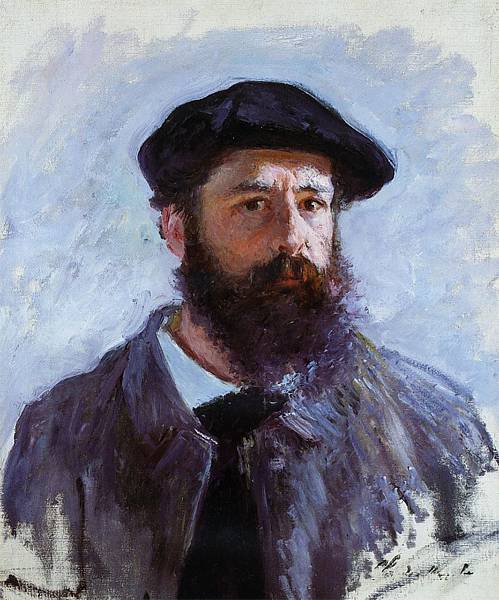
CLAUDE MONET (1840 -1926)
'Self Portrait with Beret' 1886 (oil on canvas)
Monet died, aged 86, on December 5th 1926 and was buried in the church grounds at Giverny. To label him simply as an Impressionist painter is a massive understatement. We tend to think of him a 19th century artist but his late 'Water Lily' paintings were the influential forerunners of Abstract Expressionism which emerged barely 20 years after his death. All things considered, Monet was an artistic colossus who stands with one foot at the beginning of modern art and the other at its end.
-
1840 - Monet is born in Paris.
-
1845 - Moves with his family to Le Havre on the Normandy coast.
-
1858 - Eugène Boudin introduces Monet to 'plein-air'painting.
-
1859 - Monet moves to Paris to study art.
-
1862 - Meets Pierre Auguste Renoir, Edouard Manet, Alfred Sisley and Johan Jongkind.
-
1867 - Monet's son Jean is born to Camille Doncieux.
-
1869 - Monet and Renoir paint together at 'La Grenouillère'.
-
1870 - Monet marries Camille Doncieux and visits England.
-
1871 - Moves to Argenteuil.
-
1872 - Monet paints 'Impression Sunrise'
-
1874 - Monet exhibits 'Impression Sunrise' at the 'Salon des Refusées' of 1874'
-
1877 - Monet paints 12 canvases of 'La Gare St. Lazare'.
-
1878 - Moves to Vétheuil.
-
1879 - Camille Doncieux dies.
-
1883 - Moves to Giverny with Alice Hoschedé.
-
1886 - Monet exhibition in New York opens to rave reviews.
-
1889 - A major retrospective in Paris secures Monet's reputation in France.
-
1890 - Monet paints 'Haystacks' series (25 canvases).
-
1891 - Monet paints 'Poplars' series during the summer and fall.
-
1892-94 - Monet paints 'Rouen' Cathedral series (around 30 canvases).
-
1893 - Monet develops his garden at Giverny to create his water lily pond.
-
1899 - Monet begins to paint 'water lilies', a subject that would occupy the rest of his life (around 250 canvases).
-
1899-1901 - Monet paints the Houses of Parliament during visits to London (19 canvases)
-
1900 - Monet enlarges the water lily pond in his garden.
-
1906 - Monet focuses exclusively on painting 'Water Lilies'.
-
1908 - Monet begins to suffer from cataracts in his eyes.
-
1911 - Alice Hoschedé dies.
-
1914 - Monet builds a studio in his garden to accommodate his series of large 'Water Lilies' canvases.
-
1926 - Monet dies at Giverny.
-
1927 - Monet's eight massive 'Water Lilies' paintings permanently installed in the Musée de L'Orangerie in Paris.

